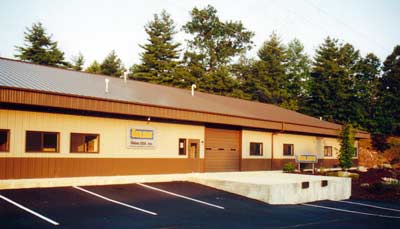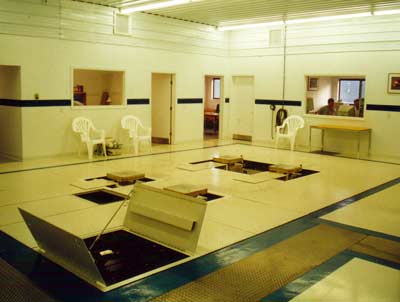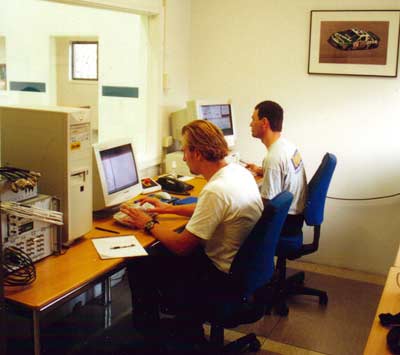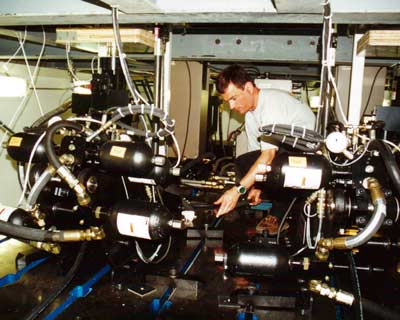INSIDE
RACING
T E C H N O L O G Y
IRT Home
IRT Home
News Page
Contents Page
Newsletter &
Books
email Paul
Ohlins 7-Post Shaker
Öhlins' 7-Post Shaker Rig in North Carolina
Öhlins USA, a division of Öhlins Racing AB of Sweden, began American operations in 1995 from an office in Chicago, Ill. Working closely with Motorsports Spares International of Indianapolis, IN; Öhlins developed the TT-44 damper, which are now mounted on the majority of open-wheel racecars in the U.S. With the goal of expansion into NASCAR and other stock-car racing series, Öhlins USA established a permanent facility in Hendersonville, North Carolina in early 1998. A motorcycle racing research and development facility also resides at this location.
In 1999 Öhlins added a 7-post dynamic testing rig at
the Hendersonville location. Mats Hedlund was hired from the
BAR Formula 1 team to run the shaker rig as manager of the Vehicle
Dynamics Group. Claes Hesling develops software and serves as
test engineer for the shaker facility.
Öhlins USA added a new building to house the shaker including
a seismic mass to isolate the instrumentation from random vibrations.

This is a photo of the Ohlins Facility. The shaker-rig room is at the far end. There's room in back of the building for a hauler to park while a racecar is unloaded. A roll-up garage door back there allows the car to be pushed into the test room. I got there early as usual and no cars ruined the view.
MTS Systems supplied the dynamic test hardware and computer control system. Öhlins developed their own measurement system and software for analysis and data presentation. A separate room in the new building houses the hydraulic pump and a 100-horsepower, water-cooled electric motor.

This is a view of the test room. The control-room window is at the back right. The swing-up doors in the foreground allow access to the hydraulics under the floor. You can see the four pads the tires sit on.

This is Claes Hesling and Mats Hedlund in the control room. They're looking out into the test room.
Seven hydraulic actuators with fluid accumulators and control systems sit on the seismic mass about seven feet below the shop floor. The four tire pads are topped with three highly accurate load cells each and readings from these sensors are averaged to give the instantaneous load on each pad. These pads are a fabricated laminated construction using aircraft-quality birch and aluminum sheet for high shear strength, light weight, and stiffness.

Mats scrambles around among the hydraulic comonents lining up the actuators and fixing them to the car.
Three other actuators are movable to accommodate chassis mounting points on different types of racecars. For open-wheel cars an adapter is bolted to the front of the chassis to accommodate the mounting of two actuators. A single actuator controls the rear of the car.
These three actuators add forces to the car to simulate aerodynamic or weight transfer forces that would be seen on the car at the track and in the corner being simulated. The control system moves these actuators to maintain the desired forces as the wheel input actuators work the car. "In any seven-post rig there is some measurable force error from these downforce actuators," said Mats Hedlund. "But we tune the controllers to make these errors small and out of phase with the wheel posts so there isn't any added artificial damping. The error levels here are the smallest I've ever seen on seven-poster. That's very important for accurate analysis."
The Goal of the Test
Mats Hedlund describes dynamic testing, "Information from the test should give a race team more mechanical grip but also less motion in pitch. Pitch is a disturbance to the driver. The driver will have better feedback about the handling if the car is pitching less into a corner. The driver might interpret that as the car being loose [oversteer] or tight [understeer]. We try to explain that to the teams and use our test rig to come up with a setup with less pitch and more grip.
"Open-wheel racecars like Champ cars tend to have higher spring rates but less damping than the big stock cars which have lower spring rates [as low as 150 or 200 lb./in. at the rear.]. Open wheel cars need less damping at low damper-shaft speeds while stock cars have more, giving sharper force/velocity curves on damper dynos.
"Stock car setups are dominated by driver comfort but lap times are the real determining factor. Long races in the NASCAR series make driver comfort even more important. Most of the time the setup is a compromise between grip and pitch. We spend a lot of time explaining our process and data to the teams. How the data transfers to the team depends on how the driver and crew chief or engineer interact. In the end the driver has to feel comfortable with the setup that comes out of our test."
More on the test set-up and data from the test in later articles.
Contact Ohlins in No. Carolina at 828-692-4525.